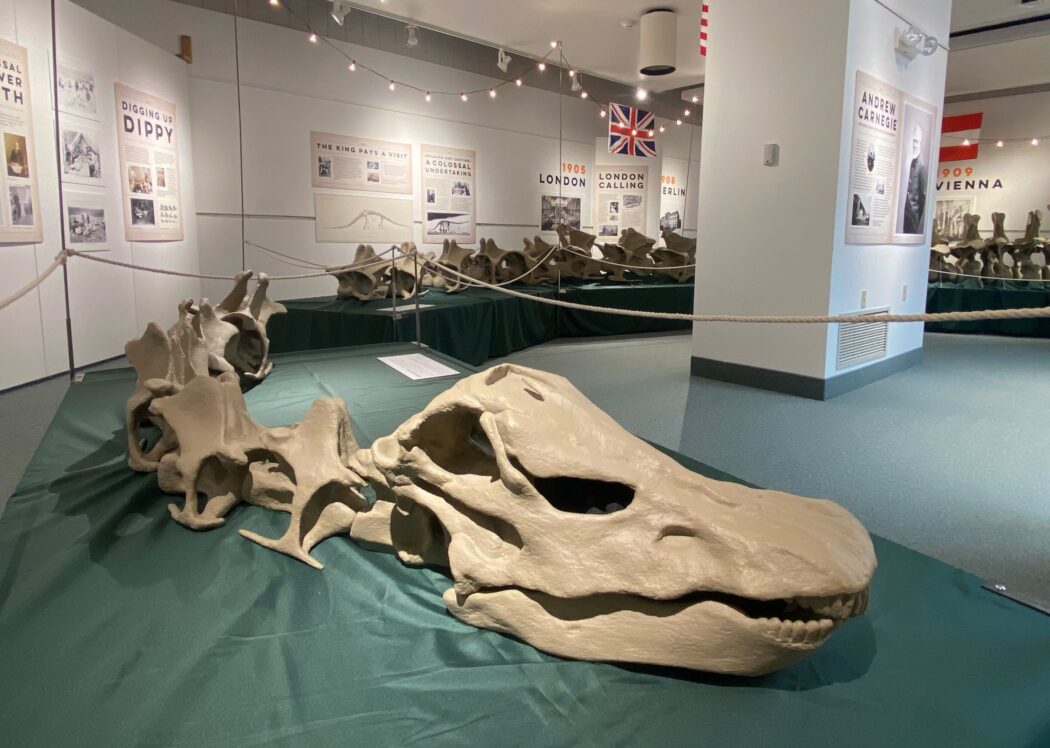Dippy the dinosaur: The fossil that traveled the world
The USU Eastern Prehistoric History Museum is hosting a special exhibit for Dippy the Diplodocus this year. Dippy is a cultural icon who was one of the first dinosaurs to travel the world, going to museums as far away as Russia and as close as Mexico.
Christopher Henderson is the head of exhibits at USU Eastern’s Prehistoric Museum, who was in charge of putting together Dippy’s new exhibit.
“We wanted to focus on this concrete cast that we have of Diplodocus carnegii,” Henderson said. “It is a species of Diplodocus that was discovered in 1899 on paleontological digs, sponsored by Andrew Carnegie.”
Andrew Carnegie was the philanthropist who funded the dig that discovered the Dippy fossil. The paleontology team discovered the fossil north of Medicine Bow, Wyoming in a formation that dates back between 152-154 million years old.
Timothy Riley, the director and curator of archaeology, also helped bring Dippy’s new exhibit to USU Eastern.
“The fossils were recovered from the Morrison Formation, a sequence of Upper Jurassic sedimentary rock which has been one of the richest formations for dinosaur fossils,” Riley wrote in a response.
Carnegie had a dream. He hoped this new discovery of the Diplodocus carnegii could help him reach this dream. He planned to use the fossil to promote world peace.
“He decided he would donate a cast of this Diplodocus to any head of state around the world that requested one,” Henderson said. “He, and the Natural History Museum in Pittsburgh, ended up donating 10 casts of this Diplodocus to 10 countries around the world between 1905 and 1934. It was the first mounted dinosaur that millions and millions of people had ever seen.”
Nowadays, most museums of paleontology have at least one mounted dinosaur cast. Casts are fossils where the bones are completely visible instead of sticking out of rocks. They help accurately convey the massive scale these creatures had.

This exhibit closes at the end of 2024. Over 8000 people have visited Dippy in the past four months.
In 1957, USU Eastern was able to obtain the Utah Fieldhouse Museum’s concrete cast of Dippy from the mold in Pittsburgh’s Carnegie Museum. After that, the concrete cast was displayed in Vernal, Utah until 1989 when the fossil was taken down.
“We acquired the concrete cast as a transfer from Utah State Parks in 2013 and then spent about 2 years restoring it, (it had been taken down in vernal in 1989 due to disrepair),” Riley wrote. “The long term goal is to remount Dippy somewhere here in Price.”
Now Dippy has a chance to be back in the spotlight. After spending so long in the dark, it is ready to amaze a new generation with his story.
“We’ve had this animal in our collections now for almost 10 years without a place to put it up,” Henderson said. “And we thought the story was so interesting and compelling. We wanted to bring the cast out of our collections — put it up in our gallery.”
Dippy has left a lasting impact on the world. Not only was the fossil in national newspapers, he was an inspiration for one of the first animated films.
“Diplodocus are one of the most recognized of all dinosaurs,” Riley wrote. “This is due to several factors, including the large number of recovered specimens and overall size, but mostly due to the efforts of Carnegie highlighted in this exhibit.”
Carnegie wanted to be able to share this creature with as many people as possible. By donating the casts around the world, Carnegie was able to spread the story of Dippy to people that had little knowledge about the magnitude of the discovery.
“My favorite part is the sheer scale of the animal,” Riley wrote. “This is one of the reasons dinosaurs and, particularly, sauropods captured the public imagination during the “bone wars” and second dinosaur rush. While there are bigger sauropods known, most are only known from incomplete skeletons. Dippy is one of the longest dinosaurs known from a complete skeleton.”
One of Dippy’s biggest accomplishments is the community he built between museums around the world, promoting friendship between the scientific and public committees.
“My favorite part is probably telling the story,” Henderson said. “Researching the story of Andrew Carnegie, this legendary philanthropist who was trying to use this dinosaur, this object of science to create international goodwill and foster world peace. It was really a beautiful dream, you know, and we wanted to retell that story.”
Carnegie’s dream of world peace may not have been fulfilled yet, but thanks to the USU Eastern team, Carnegie’s dream is able to live on and spread around the world.

